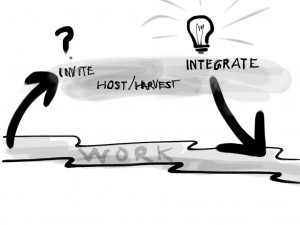Basic design for extraordinary conversations
Art of Harvesting, Art of Hosting, Conversation, Design, Facilitation, Invitation, Leadership, Organization
 A basic diagram for hosting questions that create extraordinary conversations. In the life of organizations and communities there are times when questions arise that just can’t be dealt with in the regular course of events. This is often when those of us who are consulting facilitators are brought into an organization. We are often told that “we have reached a place where we need a facilitator to help.” Usually there is an obvious need or purpose stated right in the first few sentences of the phone call or the email. This is something that consultants like us have to bear in mind.
A basic diagram for hosting questions that create extraordinary conversations. In the life of organizations and communities there are times when questions arise that just can’t be dealt with in the regular course of events. This is often when those of us who are consulting facilitators are brought into an organization. We are often told that “we have reached a place where we need a facilitator to help.” Usually there is an obvious need or purpose stated right in the first few sentences of the phone call or the email. This is something that consultants like us have to bear in mind.
The organizations we work with are in a constant flow of work. We were are hired to help facilitate something around a question that comes up, we have to remember that what we are doing is taking something out of the flow of work, turning it over and returning it to the stream. Unless we are involved in deep systemic change – where the banks of the river change as it were – our work is about diverting some time and attention from the mainstream.
To do this well, there are three basic phases to pay very close attention to. Each of these phases has to be designed in the beginning, but with space for emergent outcomes. Think of this model as a framework for holding the flow of an extraordinary event in the life of an organization. That could mean a one day think tank, a three day off-site or a two-hour staff meeting.
First there is the invitation phase. In this phase, we have to pay careful attention to inviting people well into our process. Among other things, participants have to know:
- What the clear purpose is
- How this will affect their work
- Why they should take time and attention away from their regular tasks
- What is required of them to participate well.
A skillful invitation invites people to suspend their day-to-day concerns to give their attention fully to the task at hand. For extraordinary meetings, especially those where the gathering is held in a different way than expected, it’s important to brief people before hand about how their roles might be different than they expected.
The second phase is hosting and harvesting. Of course this is the meat of any meeting, but I’m a strong advocate for focusing on the harvest primarily in the design and letting that determine the processes you will use to host. What is the purpose of the meeting? What impact is it intended to have? How will we capture and share the results and where will they go? From those questions choosing processes will be simpler. Choose processes that get you to that desired outcome.
A further consideration for hosting and harvesting is to balance the three domains of work, relationship and co-learning. I have written more about that elsewhere, but the essence is that balancing those three foci will give you an experience where work is at the forefront, learning together helps figure your way through the questions and building relationships ensures sustainable results.
The final stage is integration whereby we give some deep consideration to how the results of an extraordinary conversation can be re-integrated back into the organization. There are manyfactors to consider here, and some of them include:
- communicating results to those that weren’t there, especially the qualitative and non-visible results
- working with power and leadership
- dealing with resourcing issues
- balancing the need for new action with the reality of mundane tasks back in the main stream
- working with and supporting new ideas that might be at odds with the existing flow and structure
There are of course a myriad of issues with integrating new ideas and shifts in direction back into the life of an organization, but if there is one piece of advice I can give it is this: think about it before you have to do it. The worst case scenario for success is that an extraordinary conversation results in a stunning insight but that there is no way to reintegrate that back into the work of the organization.
Pay attention to these three stages up front, in the design process. Create questions around each of these stages and ask them of your planning team. Never be afraid to deviate from the “plan” but try to keep your thinking ahead of the game.

